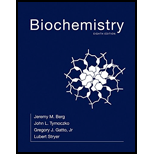
Interpretation:
The reaction which links the process of glycolysis, citric acid cycle also the enzyme involved in it needs to be explained.
Concept Introduction:
Answer to Problem 1P
Pyruvate dehydrogenase enzyme complex is required for the linking of glycolysis and TCA. It helps in the conversion of pyruvate into acetyl CoA. Acetyl CoA then enters into the series of the citric acid cycle.
Explanation of Solution
Glycolysis is a catabolic process. In this process, one glucose molecule is converted into two molecules of pyruvate. The energy released during this process is useful in the formation of high-energy adenosine triphosphate (ATP) molecules and reduced nicotinamide adenine (NADH) molecules.
The citric acid cycle is a catabolic process. It is also known as the Krebs cycle or TCA cycle. In this cycle, a series of
The reaction which links the process of glycolysis and citric acid cycle also, the enzyme involved in it is as follows:
Pyruvate dehydrogenase enzyme complex is required for the linking of glycolysis and TCA. It helps in the conversion of pyruvate into Acetyl CoA. Acetyl CoA then enters into the series of the citric acid cycle.
Want to see more full solutions like this?
Chapter 17 Solutions
Biochemistry
- True or False? Intermediates in the glycolysis pathway can be a source of raw material if the cell wants to construct biological molecules such as triglycerides or amino acids, but the citric acid cycle cannot be used this way.arrow_forwardBIOMOLECULES - MULTIPLE CHOICE - Please answer properly QUESTION : Supposed you want to use phosphoglucomutase to breakdown glycogen. You found out that this enzyme is responsible for converting glucose 1-phosphate (C6H13O9P) to glucose-6-phosphate (C6H13O9P). Based on this action, to which enzyme class does phosphoglucomutase belong? A. Isomerase B. Oxidoreductase C. Lyase D. Ligasearrow_forwardPls help ASAP, thank you! "Match the gluconeogenic precursor to the type of reaction(s) that bring it to gluconeogenesis as pyruvate" (answer choices for all drop down menus are: "alanine", "lactate", "glycerol", and "glutamine")arrow_forward
- Etiology? What does that mean? What does the fact that rotenone appears to increase the susceptibility to Parkinson disease indicate about the etiology of Parkinson disease?arrow_forwardQuestion:- Explain why it makes sense for the PDH complex in liver to be active when dephosphorylated.arrow_forwardBIOMOLECULES - MULTIPLE CHOICE - Please answer properly QUESTION : The coenzyme biocytin is associated with which of the following vitamins? A. pyridoxine B. thiamine C. biotin D. nicotinic acidarrow_forward
- kcat = ? an enzyme has an aspartic acid in the active site with a pKa = 4.0 and the kcat for this enzyme is directly proportional to the fraction of this side chain that is ionized. If the kcat at pH = 4.0 is 52.9x103 s-1 what is the kcat for this enzymes at pH 3.5arrow_forwardEfficiency of ATP Production in Muscle: The transformation of glucose to lactate in myocytes releases only about 7% of the free energy released when glucose is completely oxidized to CO2 and H2O. Does this mean that anaerobic glycolysis in muscle is a wasteful use of glucose? Explain.arrow_forwardTrue or false? Under anaerobic conditions, the pyruvate dehydrogenase complex is responsible for the irreversible conversion of pyruvate to acetyl CoA.arrow_forward
- Isoform of Lactate dehydrogenase LDHarrow_forwardGlycerophospholipids Phosphatidylethanolamine 2. Calculate the net ATP yield per fatty acid after complete oxidation. Show your solution using a table of pathways, reducing equivalents, and ATParrow_forwardSerine protease enzyme mutation To show differences in the effect of the nucleophilic attack of the carbonyl group (C=O) of peptide bond between the catalytic triad of serine, histidine and aspartic acid, and another catalytic triad contains alanine, histidine and aspartic acid Provide/ draw an example of catalytic mechanism with catalytic triad contains alanine, histidine and aspartic Please answer completely will give rating surelyarrow_forward
 BiochemistryBiochemistryISBN:9781305577206Author:Reginald H. Garrett, Charles M. GrishamPublisher:Cengage Learning
BiochemistryBiochemistryISBN:9781305577206Author:Reginald H. Garrett, Charles M. GrishamPublisher:Cengage Learning
